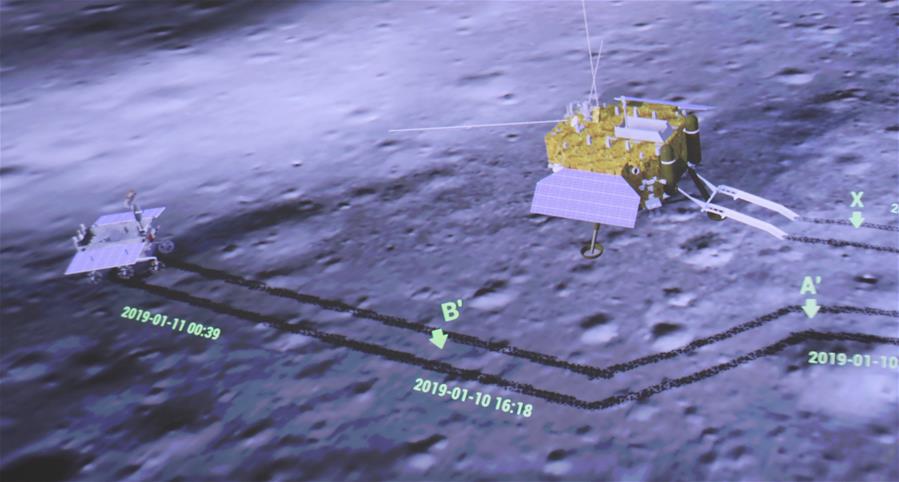
The screen at the Beijing Aerospace Control Center shows the Chang'e-4 lander (R) and the Yutu-2 rover taking pictures for each other, Jan. 11, 2019. (Xinhua/Jin Liwang)
BEIJING, Jan. 11 (Xinhua) -- China announced Friday that the Chang'e-4 mission, which realized the first-ever soft-landing on the far side of the moon, was a complete success.
With the assistance of the relay satellite Queqiao (Magpie Bridge), the rover Yutu-2 (Jade Rabbit-2) and the lander of the Chang'e-4 probe took photos of each other.
The scientific instruments aboard the probe worked well, and the images taken by the probe and detection data have been sent back to ground control, said the China National Space Administration (CNSA).
At 4:47 p.m. Beijing Time on Friday, the images of the lander and rover appeared on a large screen at the Beijing Aerospace Control Center, showing the Chinese national flag on both the lander and the rover with the desolate landscape dotted with craters on the far side of the moon in the background.
One of the images published by CNSA earlier on Friday is a 360-degree panorama which was pieced together from 80 photos taken by a camera on the lander after the rover drove onto the lunar surface, according to Li Chunlai, deputy director of the National Astronomical Observatories of China and commander-in-chief of the ground application system of Chang'e-4.
"From the panorama, we can see the probe is surrounded by many small craters, which was really thrilling," said Li.
Scientists have made an analysis of the terrain and landforms in the probe's landing area and planned a route for the future exploration of the rover according to the images taken by the probe.
The Chang'e-4 probe touched down at the preselected landing area at 177.6 degrees east longitude and 45.5 degrees south latitude in the Von Karman Crater in the South Pole-Aitken (SPA) Basin on the far side of the moon on Jan. 3, with the rover driving onto the lunar surface late that night.
Then the rover took a "nap" as the solar radiation raised the temperature on the lunar surface to over 100 degrees centigrade. It restarted its work on Thursday.
The lander, the rover and the relay satellite are in good condition. After the lander and the rover photographing each other, the probe will start scientific detection, said CNSA.
Named after Chinese moon goddess "Chang'e," China's lunar exploration program, which began in 2004, includes orbiting and landing on the moon and bringing samples back to Earth.
The program has achieved five continuous successes, said CNSA, referring to Chang'e-1, Chang'e-2, Chang'e-3, a test craft for Chang'e-5 and Chang'e-4.















